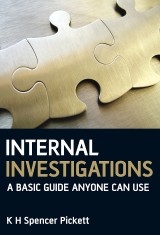Details

Internal Investigations
A Basic Guide Anyone Can Use1. Aufl.
|
48,99 € |
|
| Verlag: | Wiley |
| Format: | |
| Veröffentl.: | 22.01.2009 |
| ISBN/EAN: | 9780470743102 |
| Sprache: | englisch |
| Anzahl Seiten: | 214 |
DRM-geschütztes eBook, Sie benötigen z.B. Adobe Digital Editions und eine Adobe ID zum Lesen.
Beschreibungen
The book provides a simple but effective method for carrying out reliable and defensible internal investigations. This easy-to-use guide offers anyone asked to conduct such an investigation a working set of standards, set out in a BASIC approach that follows five main steps: Beginning the Investigation, Assessing the Issues, Substantiating the Claims, Investigating the Implications, and Communicating the results. Using the BASIC approach, all senior employees and associates will be able to to develop an important new skills-set that will help them conduct a credible internal investigation, as and when required.
<b>1 The context.</b> <p>1.1 Why investigations?</p> <p>1.2 Investigate what?</p> <p>1.3 The line manager’s role.</p> <p>1.4 A <b><i>Basic</i></b> standard.</p> <p>1.5 Using the <b><i>Basic</i></b> standard.</p> <p>1.6 To close.</p> <p><b><i>Basic</i></b> guidance.</p> <p><b>2 Corporate accountability.</b></p> <p>2.1 Why accountability?</p> <p>2.2 Links to governance.</p> <p>2.3 The outline TOR.</p> <p>2.4 Focusing on results.</p> <p>2.5 How big is the issue?</p> <p>2.6 Complaints.</p> <p>2.7 Staff discipline.</p> <p>2.8 Fraud.</p> <p>2.9 Health and safety.</p> <p>2.10 Breach of procedure.</p> <p>2.11 Whistleblowing.</p> <p>2.12 To close.</p> <p><b><i>Basic</i></b> guidance.</p> <p><b>3 Initial planning</b></p> <p>3.1 Why planning?</p> <p>3.2 Fact finding.</p> <p>3.3 The quick fix.</p> <p>3.4 Setting the detailed TOR.</p> <p>3.5 Locating hot spots.</p> <p>3.6 Establishing tasks.</p> <p>3.7 The sponsor.</p> <p>3.8 Appointing the lead investigator.</p> <p>3.9 Other roles and responsibilities.</p> <p>3.10 Resources.</p> <p>3.11 Access rights.</p> <p>3.12 Planning and control.</p> <p>3.13 Publicity.</p> <p>3.14 A short example.</p> <p>3.15 To close.</p> <p><b><i>Basic</i></b> guidance.</p> <p><b>4 Basic fieldwork.</b></p> <p>4.1 Why fieldwork?</p> <p>PART 4.I ASCERTAINING THE ISSUES.</p> <p>4.2 Considering the issues in more detail.</p> <p>4.3 Understanding the processes and operations.</p> <p>4.4 Practical examples.</p> <p>4.5 Diary of the investigation.</p> <p>4.6 Exploring Example 10.</p> <p>4.7 Moving to the next stage.</p> <p>PART 4.II SUBSTANTIATING THE CLAIMS.</p> <p>4.8 Considering claims.</p> <p>4.9 What is good evidence?</p> <p>4.10 Sources of evidence.</p> <p>4.11 Dirty tricks?</p> <p>4.12 Using samples.</p> <p>4.13 Setting an aim for the exercise.</p> <p>4.14 Further practical examples.</p> <p>4.15 Rules of evidence.</p> <p>4.16 Establishing the context.</p> <p>4.17 Exploring Example 10.</p> <p>4.18 Moving to the next stage.</p> <p>PART 4.III INFERRING THE IMPLICATIONS.</p> <p>4.19 Getting to the implications.</p> <p>4.20 What about politics?</p> <p>4.21 The Evidence ‘C’ Scale.</p> <p>4.22 Other considerations.</p> <p>4.23 Further practical examples.</p> <p>4.24 Exploring Example 10.</p> <p>4.25 To close.</p> <p><b><i>Basic</i></b> guidance.</p> <p><b>5 Basic fieldwork tools – interviewing.</b></p> <p>5.1 Why interviewing?</p> <p>5.2 Four dimensions of rapport.</p> <p>5.3 Open forum inquiry panels.</p> <p>5.4 Interviews and the <b><i>Basic</i></b> model.</p> <p>5.5 Preparing the interview.</p> <p>5.6 More on structure.</p> <p>5.7 Getting results.</p> <p>5.8 Exploring Example 10.</p> <p>5.9 Is it that easy?</p> <p>5.10 To close.</p> <p><b><i>Basic</i></b> guidance.</p> <p><b>6 Communicating results.</b></p> <p>6.1 Why communications?</p> <p>6.2 Types of reports.</p> <p>6.3 Structuring the report.</p> <p>6.4 Timeline of events.</p> <p>6.5 The investigator’s opinion.</p> <p>6.6 Recommendations.</p> <p>6.7 Recommending better internal controls.</p> <p>6.8 Risk management.</p> <p>6.9 Exploring Example 10.</p> <p>6.10 To close.</p> <p><b><i>Basic</i></b> guidance</p> <p><b>7 Quality assurance.</b></p> <p>7.1 Why quality assurance?</p> <p>7.2 Ensuring consistency.</p> <p>7.3 Establishing a <b><i>Basic</i></b> approach.</p> <p>7.4 Quality assurance checklists.</p> <p>7.5 Standardised documentation.</p> <p>7.6 It’s basically simple.</p> <p>7.7 To close.</p> <p><b>8 Beyond basics.</b></p> <p>8.1 Why a risk management culture?</p> <p>8.2 Risk scanning.</p> <p>8.3 Establishing conduct.</p> <p>8.4 Establishing controls.</p> <p>8.5 Corporate reputation.</p> <p>8.6 To close.</p> <p><b>Index.</b></p>
KH Spencer Pickett is the author of 12 books published by John Wiley and Sons (Inc and UK), and a lecturer in internal auditing, risk management and investigations. He is a member of ACCA Corporate Governance and Risk Management Committee and of ACCA Internal Audit Members Network, and an executive committee member of the UK’s Control Risk Self Assessment Forum.
‘This important new book gives much-needed guidance, standards and support in investigations into those all too frequent issues like complaints, reckless business decisions, staff grievances, errors, systems failures, unexplained losses, poor performance and allegations against employees and/or associates. <p>Unfortunately, many investigations are conducted by people who have no methodical approach at hand to lend credibility to their efforts. A poorly conducted enquiry will result in unreliable results along with claims of a “cover up”. The original problem is then compounded by these additional problems that may leave the organization vulnerable to claims and civil action as well as causing unwelcome embarrassment.</p> <p>To ensure sensitive risks are properly investigated and addressed, this book has developed a simple but effective method for carrying out internal investigations based on a BASIC approach that follows five main steps:</p> <ul> <li><b>B</b>eginning the Investigation</li> <li><b>A</b>ssessing the Issues</li> <li><b>S</b>ubstantiating the Claims</li> <li><b>I</b>nvestigating the Implications</li> <li><b>C</b>ommunicating the results</li> </ul> <p>This five step framework will ensure credibility in internal investigations through guidance, examples and an underlying theme of training people to a basic, but effective standard. The book’s basic approach can be used to develop an important new skills-set that will ensure the reader is able to carry out successful investigations, as and when required. Moreover, this BASIC guidance can be used to set clear corporate standards and staff training that can be rolled out across the entire organization.’</p>
Diese Produkte könnten Sie auch interessieren:

Counterparty Credit Risk, Collateral and Funding

von: Damiano Brigo, Massimo Morini, Andrea Pallavicini

69,99 €
















